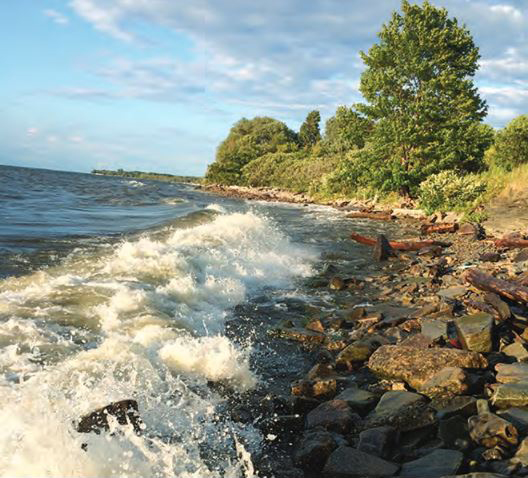Contact:
Heather Weitzner, Great Lakes Coastal Processes and Hazards Specialist, New York Sea Grant, E: hw528@cornell.edu, P: 315.331.8415
Newark, NY, October 12, 2015 - A shoreline is a dynamic environment that evolves under the effects of both natural and human influences. Many areas along New York’s shorelines are naturally subject to erosion.
Although human actions can impact the erosion process, natural coastal processes such as wind, waves or ice movement are constantly eroding and/or building up the shoreline.
From narrowing beaches to eroding bluffs, the results of these processes can impact not only human-made coastal features, but also the opportunities for humans to interact with the shoreline, creating a fragile relationship between natural coastal changes and human use of the coast.
This constant change may seem alarming, but erosion and accretion (build up of sediment) are natural phenomena experienced by the shoreline in a sort of give and take relationship. This relationship is of particular interest due to its impact on human uses and development of the shore.
These processes and causes of erosion and accretion affecting New York’s shorelines are the focus of a New York Sea Grant four-page fact sheet (pdf).
For additional publications and to learn more about these processes, their effects on different coastal landforms, and how you can protect your shoreline, see New York Sea Grant’s Great Lakes Coastal Processes Web site, www.nyseagrant.org/glcoastal.

A shoreline is constantly morphing through erosion and accretion influenced by a number of coastal evolution processes, including waves, like the ones breaking here on the eastern Lake Ontario shore. Photo by Brittney Rogers / NYSG.
More Info: New York Sea Grant
New York Sea Grant (NYSG), a cooperative program of Cornell University
and the State University of New York, is one of 33 university-based
programs under the National Sea Grant College Program (NSGCP) of the
National Oceanic and Atmospheric Administration (NOAA). The NSGCP
engages this network of the nation’s top universities in conducting
scientific research, education, training and extension projects designed
to foster science-based decisions about the use and conservation of our
aquatic resources. Through its statewide network of integrated
services, NYSG has been promoting coastal vitality, environmental
sustainability, and citizen awareness about the State’s marine and Great
Lakes resources since 1971.
New York Sea Grant maintains Great Lakes offices at SUNY Buffalo, the
Wayne County Cooperative Extension office in Newark and at SUNY Oswego.
In the State's marine waters, NYSG has offices at Stony Brook University
and Stony Brook Manhattan, in the Hudson Valley through Cooperative
Extension in Kingston and at Brooklyn College.
For updates on Sea Grant activities: www.nyseagrant.org has RSS, Facebook, Twitter, and YouTube links. NYSG also offers a free e-list sign up via www.nyseagrant.org/coastlines for its flagship publication, NY Coastlines/Currents, which is published several times a year.